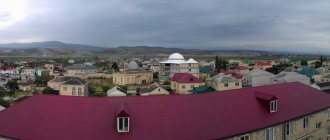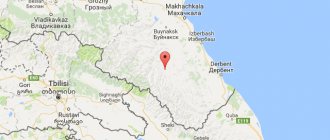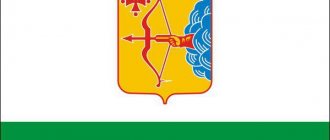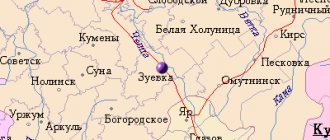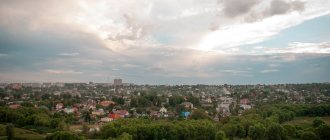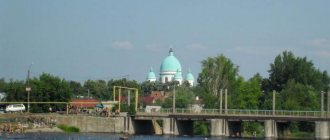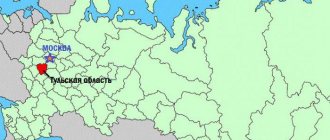General information about the Kirov region
Distinctive features .
Periphery. Such a short but succinct word can characterize the historical essence of the land of Vyatka, now called the Kirov region. The first cities in these lands were founded by settlers from Veliky Novgorod, and after the invasion of the Mongol-Tatars, the local population quickly began to swell with refugees from the southeast. By the will of fate, Vyatka found itself at the crossroads of interests of the strongest states of northeastern Europe - the Novgorod Republic, Volga Bulgaria, and the Vladimir-Suzdal Principality. The Vyatchans had to fight a lot with their neighbors, and they entered into alliances either with Suzdal or with Moscow. And as a result, in the 15th century, Vyatka became part of the Moscow state.
Assumption Trifonov Monastery in Kirov. Photo by Vladimir Ogleznev (https://fotki.yandex.ru/users/trans338/)
Vyatka represents a classic example of a Russian province. They say that Saltykov-Shchedrin, when writing his famous satirical work “The History of a City,” used Vyatka as a prototype. Moreover, analyzing the unforgettable masterpiece of Ilf and Petrov “12 chairs”, some argue that in the homeland of Kisa Vorobyaninov - “county town N” - features of Vyatka can also be traced. And Kisa’s rich ancestor painfully resembles the merchant of the first guild Stakheev, a native of the Vyatka lands.
However, if we ignore the literature and return to reality, today the Kirov region is an industrially developed region, where mechanical engineering and metalworking, chemical and forestry industries play a major role. But the region lives not only with modern production. Folk crafts that delight the Russian soul are also loved and remembered here.
The famous Dymkovo toy - painted clay whistles - is a local pride. Another pride is Vyatka lace, with its unique weaving technology. In general, the historical memory of local residents is such that many will envy. Maybe this is why the local native, the great Russian artist V.M. Vasnetsov, loved to turn to the theme of Russian folklore in his paintings? It is possible that Russian culture in the Vyatka region is absorbed along with mother’s milk.
Geographical location . The Kirov region is part of the Volga Federal District. Neighboring it are: in the east - the Perm Territory and Udmurtia, in the north - the Komi Republic, the Arkhangelsk region, in the south - the Mari El Republic and Tatarstan, in the west - the Kostroma, Nizhny Novgorod and Vologda regions.
The terrain is predominantly hilly. There are several large hills (one of them is Vyatskie Uvaly), almost 20 thousand rivers. But the main river is the Vyatka, which flows into the Kama. The main natural zones in the region are coniferous and mixed forests. There is a large nature reserve - Nurgush, as well as several reserves.
Population. As of 2013, the population of the region was 1,319,076 people. Of these, 72% live in cities. Population density - 10.96 people. per sq. m. The main nationalities are Russians (89.44%), Tatars (2.72%), Mari (2.12%), Udmurts (1%). The ratio of male to female population is 45.9%: 54.1%. The region is characterized by a slight excess of mortality over the birth rate (2.8 people per 1000 population). Since there are very few people who want to move here, rather the opposite, the population of the region is gradually melting away.
Participants in the opening ceremony of the Universiade in Kirov
Crime . The Kirov region is not a criminal region. In the federal ranking it ranks 49th in terms of the number of crimes committed. In general, everything here is quiet and calm.
The unemployment rate in the Kirov region is 7.10%. Unfortunately, business activity in the region is not very high, and there are not enough large machine-building enterprises to provide everyone with work. On the other hand, the money offered for work is not so great that there would be a lot of people willing to work for it. The average salary in 2012 was only 16,783 rubles.
Property value. Housing prices in Kirov are relatively low. The average cost per square meter in the city is 46,122 rubles. A one-room apartment in the center can be bought here for 1.3 million rubles. For a good two-room apartment you will have to spend much more - 2.5 million rubles and more.
Climate. The Kirov region is located in northern latitudes, and therefore there are frequent severe frosts in winter and sharp cold snaps in summer. The climate type is temperate continental. The average temperature of the coldest month of January is −15°C. The average temperature in July is +18°C. Precipitation is quite frequent here. The average annual precipitation is 680 mm Hg. Art.
Historical landmarks
Each region has attractions that tell its history in detail and in colors, showing the path traveled from antiquity to the present day.
Zhukovlyansky boulders
- Coordinates: 58.304727, 48.018566.
One of the mysteries of the Zhukovlyansky sand quarry is the huge round boulders. Their size reaches 3 m, and their quantity is 1500 pieces. It is still unknown where the stones among the sands came from. There are rumors among the locals that the stones are alive and can breathe. And if you touch them and make a wish, it will definitely come true.
Kovrov settlement
- Coordinates: Kovrovy village, Kotelnichesky district.
An ancient settlement at the mouth of the river. Moloma, not far from the village of Kovrovy, was discovered back in 1881. It is believed that it was one of the first settlements of the Vyatichi. During excavations of the settlement, archaeologists found a conflagration of an ancient Russian dwelling dating back to the 13th century and products from the same period.
In addition, the finds include the remains of an adobe oven, arrowheads, various tools and lead seals. Unfortunately, the archaeological monument is now under threat of destruction due to the proximity of arable land to it.
Pareiasaurus Cemetery
- Address: Kotelnich city.
One of the world's largest cemeteries of ancient pareiasaurs is located in the Kirov region. These ancient lizards are much older than dinosaurs; they went extinct about 250 million years ago under unclear circumstances.
This place is located under Sokolya Mountain, not far from the town of Kotelnich. Here, bones and skulls of fossil reptiles can be found anywhere on the beach. Currently, excavations under Sokolya Mountain are underway, but the excitement caused by the finds is gradually fading.
Istoben settlement
- Coordinates: 58.425827, 48.826946.
Istobensk in the Orichevsky district is a legendary place. Not far from it is the ancient Istoben settlement - a historical and archeological monument of federal significance. The first studies of the ancient settlement were carried out at the end of the 19th century. Thanks to this, the history of the settlement of the Vyatka land by the ancestors of the Mari and Udmurts was studied.
Cities of the Kirov region
Kirov, or Vyatka, as it was called in the old days, is the regional center and the largest city in the region. Population - 473,688 thousand people. Since 1970 it has been a historical city of Russia. This means that there are many historical and architectural monuments located here that are of great value for the Russian Federation.
This is a large regional industrial center. But, unfortunately, there is not much reason for joy here. Terrible roads, low wages, environmental problems, dilapidated housing stock that requires major repairs. The advantages include a relatively favorable crime situation and beautiful nature in the surrounding area.
Kirovo-Chepetsk is the second largest city in the region, population - 77,166 people. It is located just 22 km from Kirov and is part of the Kirov agglomeration. It was founded in 1935 due to the Kirovo-Chepetsk thermal power plant being built here. At first it was a small workers’ village, and it became a city only 20 years later.
In addition to the power plant, there are several large enterprises here: a mineral fertilizer plant, a mechanical repair plant and a number of other production facilities. Kirovo-Chepetsk has the same problems as Kirov, only raised to the second degree. If you find yourself on one of its streets, you get the impression that you got into a time machine and found yourself in the era of Gorbachev’s perestroika.
Slobodskoy is the third largest city in the region, with a population of 36 thousand people. Part of the Kirov agglomeration. Despite its small size, this ancient city was known at the end of the 15th century. Slobodskaya is also the birthplace of the writer Alexander Green, who gave us Scarlet Sails. The city has a long trading tradition, and today there is a developed food industry, as well as the production of matches and fur products.
Number of people living in the capital and regional cities
Kirov is the regional capital. Therefore, residents of villages and villages flock there. According to 2021 statistics, the heart of the Kirov region is home to a population of 500,836 people. But in 2016 the figures were slightly lower – 495,998 people.
The population growth in Kirov is made up of applicants who come from villages, villages or nearby regions during the period of admission to universities. In addition, the number of residents is replenished by the working population who moved to the regional capital.
In 2015, Kirov took 37th place in the ranking of cities by the number of residents (then the indicators were recorded at 493,336 people).
By gender composition: there are more women than men. The percentage is 56%.
In terms of ethnic composition, Russians predominate. They make up 96% of the total number of residents.
In second place in terms of territorial and economic growth is the city of Kirovo-Chepetsk. In terms of population, it also ranks 2nd - 73,279 citizens. However, this figure is slightly lower compared to other years.
Kirovo-Chepetsk is located in 221st place out of 1112 possible in the list of Russian cities by number of residents.
According to its national composition, the city united the following peoples on its territory:
- Russians (95%);
- Tatars (1.5%);
- Udmurts (1.04%);
- Mari (0.23%).
The third largest city in the Kirov region is Slobodskaya. It has a population of 33,115.
And in 4th place is Vyatskie Polyany with a population of 32,817 inhabitants.
Every year, even in large cities of the Kirov region, there is a tendency for the urban population to decrease. And there are two reasons for this: low birth rate and high death rate. As well as the emigration of the indigenous population to more promising cities. This becomes evidence that these localities have weak economic indicators that affect the standard of living of its residents.
Population of the region
Until 1934, the city was called Vyatka, so the oldest residents are often called Vyatchans (erroneously Vyatichi).
The population of the Kirov region, according to statistics, is gradually declining. This is due to the fact that young people are leaving their hometowns for Moscow, as well as other large and more promising cities.
Comparing data from 15 years ago (2002) and the 2017 census, one can see that the population of the Kirov region has decreased by almost 300,000 inhabitants.
As of January 1, 2021, calculations showed that 1292.1 thousand people live in the region. In 2021, their number decreased by 5,400. The reason for this significant decline is low birth rates, but the number of registered deaths is 1.2 times higher.
